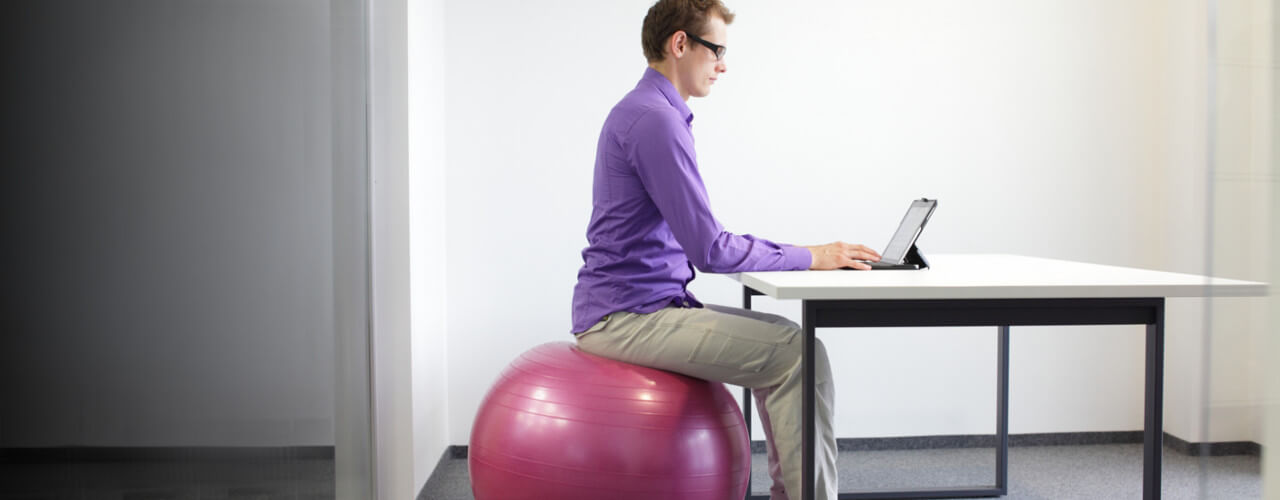Over time, poor posture may be caused by habits from everyday activities such as sitting in office chairs, staring at the computer, cradling a cell phone, carrying a purse over the same shoulder, driving, prolonged standing, caring for small children, or even sleeping.
Poor posture can easily become second nature, causing and aggravating episodes of back and neck pain and damaging spinal structures. Fortunately, the main factors affecting posture and ergonomics are completely within one’s ability to control and are not difficult to change.
The following guidelines suggest several ways to improve posture and ergonomics, especially for people who work sitting in an office chair for most of the day.
1.Identify the warning signs of back pain caused by poor ergonomics and posture.
Back pain may be the result of poor ergonomics and posture if:
- the back pain is worse at certain times of the day or week – such as after a long day of sitting in an office chair in front of a computer, but not during the weekend
- the pain starts in the neck and moves downwards into the upper back, lower back, and extremities
- the pain goes away after switching positions
- it is sudden back pain that is experienced with a new job, a new office chair, or a new car
- it is back pain that comes and goes for months
2.Keep the body in alignment while sitting in an office chair and while standing.
When standing: distribute body weight evenly to the front, back, and sides of the feet.
While sitting in an office chair: take advantage of the chair’s features. Sit up straight and align the ears, shoulders, and hips in one vertical line. Any prolonged sitting position, even a good one, can be tiring. Shifting forward to the edge of the seat with a straight back can alternate with sitting back against the support of the office chair to ease the work of back muscles.
Some people benefit from a naturally balanced posture that is achieved by sitting on a balance ball. In this posture, the pelvis is rocked gently forward increasing the lumbar curve which naturally shifts the shoulders back (similar to sitting on the edge of a chair seat).
Also, be aware of and avoid unbalanced postures such as crossing legs unevenly while sitting, leaning to one side, hunching the shoulders forward, or tilting the head.
3.Get up and move.
As muscles tire, slouching, slumping, and other poor postures become more likely; this in turn puts extra pressure on the neck and back. To maintain a relaxed yet supported posture:
- change positions frequently
- take breaks from sitting in an office chair every half hour for two minutes to stretch, stand, or walk
4.Use posture-friendly props and ergonomic office chairs when sitting.
Supportive ergonomic “props” can help to take the strain and load off of the spine.
- Ergonomic office chairs or chairs with an adjustable back support can be used at work\
- Footrests, portable lumbar back supports, or even a towel or small pillow can be used while sitting in an office chair, on soft furniture and while driving
- Using purses, bags, and backpacks that are designed to minimize back strain can also influence good posture
- Proper corrective eye wear, positioning computer screens to your natural, resting eye position can also help to avoid leaning or straining the neck with the head tilted forward.
5.Increase awareness of posture and ergonomics in everyday settings.
Becoming aware of posture and ergonomics at work, at home, and at play is a vital step towards instilling good posture and ergonomic techniques. This includes making conscious connections between episodes of back pain and specific situations where poor posture or ergonomics may be the root cause of the pain.
6.Use exercise to help prevent injury and promote good posture.
Regular exercise such as walking, swimming, or bicycling will help the body stay aerobically conditioned. Specific strengthening exercises will help the muscles surrounding the back to stay strong. The benefits of exercise promote good posture, which will, in turn, further help to condition muscles and prevent injury.
There are also specific exercises that will help maintain good posture. In particular, a balance of core muscle and back muscle strength is essential to help support the upper body and maintain good posture.
7.Wear supportive footwear when standing
- Avoid regularly wearing high-heeled shoes, which can affect the body’s center of gravity and induce compensatory alignment of the entire body, thus negatively affecting back support and posture.
- When standing for long periods of time, propping a leg up on a foot rest, wearing supportive shoe orthotics, or placing a rubber mat on the floor can improve comfort.
8.Remember good posture and ergonomics when in motion.
Simply walking, lifting heavy materials, holding a telephone, and typing are all moving activities that require attention to ergonomics and posture. It is important to maintain good posture even while moving to avoid injury, walking tall with shoulders back for example.
Back injuries are especially common while twisting and/or lifting and often occur because of awkward movement and control of the upper body weight alone.
9. Create ergonomic physical environments and workspaces, such as sitting in an office chair at a computer.
It does require a small investment of time to personalize the workspace, home, and car, but the payoff will be well worth it. Undue strain will be placed on the structures of the spine unless the office chair, desk, keyboard, and computer screen, etc. are correctly positioned.
It’s much easier and less time consuming to correct everyday ergonomics and minimize back or neck pain than to add doctor visits and corrective therapies for debilitating pain condition.
10.Avoid overprotecting posture.
Remember that it is important to maintain an overall relaxed posture. Avoid restricting movements by clenching muscles or adopting an unnatural, stiff posture. For individuals who already have some back or neck pain, it’s a natural tendency to limit movements to avoid provoking increased pain.
However, unless there is a fracture or other serious problem, the structures in the spine are designed for movement and any limitation in motion over a long period of time creates more pain and a downward cycle of less motion and more pain.
Tags: Rehabilitation, chronic pain, Natural Pain Relief, Aches and Pains, Nutrition, Natural Treatment, Physical Health, Opioids, Physical Activity


